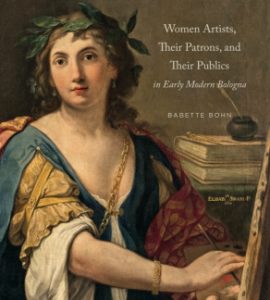This March, TCU celebrates Women’s History Month and recognizes faculty members whose work highlights the contributions of women throughout history.
Two newly published books by TCU School of Art faculty members in the art history program cover the lives and careers of prominent female artists in varying time periods in European history.

“Women Artists, Their Patrons, and Their Publics in Early Modern Bologna” by professor Babette Bohn focuses on why women artists in early modern Bologna were more numerous, diverse and successful than in other areas of Italy at that time.
Professor Babette Bohn’s book, Women Artists, Their Patrons, and Their Publics in Early Modern Bologna (Penn State University Press), focuses on why women artists in early modern Bologna were more numerous, diverse and successful than in other areas of Italy at that time. It’s a topic Bohn has researched for years, including during her fellowship with the Center for Advanced Study in the Visual Arts at the National Gallery of Art in Washington, D.C.
“Slowly, over time, it became clear what a rich topic this was—enough to justify a major book project,” said Bohn. “I discovered new artists, new artworks and new documentation for their lives and careers…It became clear that Bologna was uniquely receptive to women.”
Looking at the impact that female artists had on Bologna’s culture, Bohn’s book includes extensive archival research on 68 artists, including painters, sculptors, printmakers, embroiderers and more.
Assistant professor Jessica Fripp discusses themes of friendship and rivalry surrounding prominent French female artists in the 1780s in her book Portraiture and Friendship in Enlightenment France (University of Delaware Press).
Adélaïde Labille-Guiard and Élisabeth Vigée-Lebrun are the focus of a chapter that explores their paths into the prestigious Royal Academy of Painting and Sculpture.

Assistant professor Jessica Fripp discusses themes of friendship and rivalry surrounding prominent French female artists in the 1780s in her book “Portraiture and Friendship in Enlightenment France.”
“During the 18th century, there were major philosophical debates about the possibility of women experiencing friendship with men or other women,” said Fripp. “Literature on [Labille-Guiard and Vigée-Lebrun] almost always discusses them in tandem and, furthermore, presents them as rivals. This rivalry was framed around their unusual status as female academicians.”
However, Fripp says there is no real evidence that the two artists disliked one another and theorizes that pitting them against each other was a product of the debate around women’s ability to experience friendship.
Fripp’s research provides an understanding of how artists used their work to promote new ideas about friendship. Notably, Labille-Guiard’s most famous painting, a self-portrait with two of her students, is featured on the cover of Fripp’s book.
To read more about TCU’s celebration of Women’s History Month, visit tcu.edu/news.
